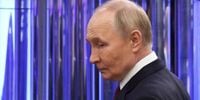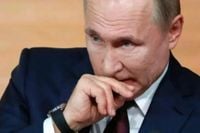In the corridors of Washington’s power, a clash of perspectives has shaped the U.S. approach to Russia and the ongoing war in Ukraine. As 2025 unfolded, a sharp divide emerged between two of America’s most influential intelligence agencies—the State Department’s Bureau of Intelligence and Research (INR) and the Central Intelligence Agency (CIA)—over whether Russian President Vladimir Putin was truly ready to negotiate an end to the conflict. According to The Wall Street Journal, this internal rift wasn’t just academic; it directly influenced high-level diplomacy, policy decisions, and even the president’s daily briefings.
At the heart of the disagreement was a fundamental question: Was Putin, often portrayed as the steely architect of Russia’s war strategy, genuinely open to peace talks? The CIA, in its assessments early in 2025, painted a cautiously optimistic picture. Their analysts believed that President Donald Trump might find opportunities to negotiate with Putin, suggesting that the Russian leader could be open to dialogue under the right circumstances. Several former officials told WSJ that the CIA’s reports highlighted potential diplomatic openings, giving the Trump administration hope that a negotiated settlement might be within reach.
But not everyone was convinced. The State Department’s INR, tasked with providing independent intelligence analysis, took a starkly different view. Drawing on Putin’s public statements—especially his insistence on the “demilitarisation” and “denazification” of Ukraine—INR analysts concluded that the Kremlin was unlikely to abandon its maximalist demands. According to European Pravda, the INR’s skepticism was rooted in a close reading of the Russian leader’s rhetoric and actions, which suggested little willingness to compromise on core objectives. This dissenting perspective, according to officials cited by WSJ, was included in the president’s daily briefings and became a persistent undercurrent in internal discussions.
The disagreement wasn’t merely theoretical; it played out against the backdrop of a rapidly evolving diplomatic landscape. In the months leading up to a planned summit between Trump and Putin in Anchorage, Alaska, the White House repeatedly sought classified assessments and briefings on Putin’s intentions. The CIA’s more hopeful analysis stood in contrast to the INR’s dour warnings, creating confusion and tension within the administration. As UNN reported, this divergence was reflected in the daily briefings provided to the president, making it clear that even America’s top intelligence minds could not agree on how to interpret the signals coming out of Moscow.
Behind closed doors, the consequences of this rift were significant. According to The Wall Street Journal, the leadership of the INR grew concerned that their dissenting views were undermining the bureau’s credibility among senior officials. In a move that raised eyebrows among intelligence professionals, several INR analysts—particularly those working in the Russia-Eurasia group—were dismissed in July 2025, while another analyst resigned. The State Department later stated that these changes were part of a broader departmental reorganization and were not targeted at any specific group. However, former employees told WSJ that the office responsible for working with private-sector experts was shut down, and the INR groups for Europe and Russia-Eurasia were merged, leading to further layoffs or reassignments.
Some former officials expressed concern that these personnel changes might stifle dissent and limit the range of perspectives available to policymakers. As one former official told WSJ, “If analysts feel compelled to provide assessments that align with policy, the administration might not get an accurate picture of events.” The fear was that, in an environment where independent analysis was discouraged, vital warning signs could be missed, and policy decisions could be skewed by groupthink.
While the intelligence debate simmered, the diplomatic clock was ticking. In mid-October 2025, President Trump held a phone call with Putin and announced plans for a new summit in Budapest, Hungary. The meeting was to be prepared by U.S. Secretary of State Marco Rubio and Russian Foreign Minister Sergey Lavrov. But hopes for a diplomatic breakthrough were quickly dashed. According to media reports cited by RBC-Ukraine, Russia refused to budge on its core demands, prompting Trump to cancel the summit. Publicly, Trump expressed frustration with the slow pace of talks and Putin’s unwillingness to halt military action in Ukraine. He declared that he would not meet with the Kremlin leader until a concrete agreement was reached to secure peace between Russia and Ukraine.
As diplomatic channels closed, Washington turned to economic pressure. On October 23, 2025, the U.S. Treasury Department imposed sweeping sanctions on Russia’s largest oil companies, Rosneft and Lukoil, as well as dozens of their subsidiaries. The move, announced in an official statement, was designed to cripple a key sector of the Russian economy and increase the cost of continued aggression. The U.S. government simultaneously called on Moscow to “immediately” agree to end the war against Ukraine, underscoring the urgency of the situation.
The Russian response was swift and defiant. According to UNN, Putin dismissed the new sanctions as “serious, but will not affect the Russian economy,” describing them as an “unfriendly act” and an attempt to exert pressure rather than a genuine effort to strengthen Russian-American relations. In a characteristically sardonic remark, Donald Trump responded to Putin’s bravado by saying he was “glad to hear about the dictator’s ‘confidence’, but would prefer to see how Russia would cope with them.”
These exchanges highlighted the deepening mistrust between Washington and Moscow, as well as the challenges facing any effort to negotiate an end to the war. The U.S. administration’s internal divisions over intelligence assessments only added to the complexity. While some officials continued to hold out hope for a diplomatic solution, others warned that Putin’s entrenched demands made meaningful progress unlikely.
The episode serves as a stark reminder of the difficulties inherent in high-stakes diplomacy, especially when adversaries send mixed signals and intelligence agencies cannot agree on how to interpret them. It also raises important questions about the value of dissent within the intelligence community, and whether policymakers are best served by a diversity of views or a unified front. As the war in Ukraine grinds on, the U.S. government’s ability to read—and respond to—Putin’s intentions remains as crucial as ever.
For now, the prospects for peace remain clouded by uncertainty, disagreement, and the hard realities of geopolitics. Washington’s internal debates may not have resolved the question of Putin’s true intentions, but they have laid bare the challenges of navigating a world where even the experts can’t always agree.

